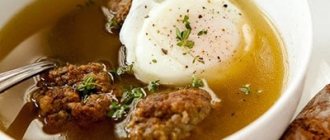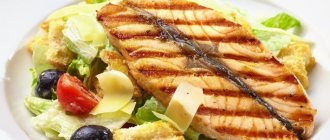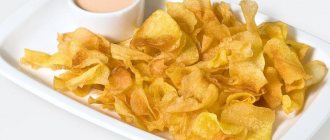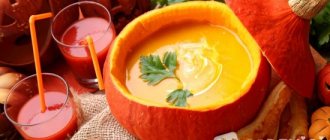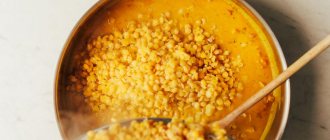Composition of puree soups
Almost any ingredients can be added to so-called cream soups, and this directly affects their composition and BJU. The first dish can be more calorie or dietary, so everyone chooses the appropriate cooking recipe.
The dish consists mainly of vegetables: cabbage, carrots, potatoes, mushrooms, tomatoes, onions and garlic. A little vegetable oil (preferably olive) is also added so that the puree soup does not turn out lean and tasteless.
The broth itself can be cooked with vegetables or meat. If you take chicken breast or beef, you will get a less nutritious dish, and pork broth will increase the calorie content of the puree soup to 150-200 kcal.
The composition may also include such non-standard ingredients as cod liver. It will increase the fat content of even the leanest vegetable soup more than butter or heavy cream, which is often used.
https://youtu.be/opsslhXtyQw
How to give/administer Frutonyanya cream soup
In the photo of the packaging you can see instructions in pictures that will help you correctly serve your child the first course from the FrutoNyanya company.
- Before opening the package, shake the contents thoroughly.
- Use a clean container and pour the recommended amount of product into it.
- Next, you should put the dish in the microwave or heat it in a water bath.
- After the package is opened, it is not recommended to store the dish in the refrigerator for longer than 8 hours.
- Soups go well with meat purees, which can be added to your baby’s plate.
- You should start getting acquainted with cream soups with one teaspoon during breakfast. If during the day the baby does not develop allergies or indigestion, then the next day the amount of complementary foods can be doubled. The dish should be introduced in this way until the baby begins to receive its recommended daily amount.
Calorie content of puree soups
Calories and nutritional value of pureed soups per 100 g of dish depend on the ingredients used for preparation. Let's consider the energy value of dishes prepared according to several of the most popular recipes:
- pumpkin soup puree contains 93 kcal per 100 grams;
- broccoli puree soup – 85 kcal;
- cauliflower dish – 33 kcal (the most dietary among all);
- The calorie content of mashed potato soup is higher - about 45 kcal;
- mushroom soup from champignons – 85 kcal per 100 g;
- tomato puree soup – 40 kcal;
- from carrots – 70 kcal;
- from lentils, peas or beans – 50-55 kcal;
- celery puree soup – 45 kcal;
- soup made from many different vegetables - 50-60 kcal;
- with the addition of chicken or turkey – 90 kcal;
- with chicken liver – 85 kcal;
- with rice cereal – 55 kcal per 100 grams.
As you can see, the calorie content of the finished dish varies. It all depends on what exactly you add to the pan.
Content of BJU in puree soups per 100 g
The ratio of proteins, fats and carbohydrates in puree soups also depends on the ingredients. The table will help you figure it out:
| For 100 g of soup | Squirrels | Fats | Carbohydrates |
| pumpkin puree soup | 3.5 | 4.5 | 10 |
| from broccoli | 2 | 4 | 14 |
| with tomatoes | 2 | 3 | 1.5 |
| from carrots | 4 | 2 | 9 |
| with champignons | 8 | 2 | 3 |
| potato | 2 | 3 | 16 |
| with poultry | 6 | 7 | 4 |
| with rice | 1.5 | 1.5 | 8 |
| pea | 1 | 3 | 8 |
As you can see, even puree soup with meat and cream, just with meat or made from potatoes does not contain so much fat that you should refuse this dish when losing weight.
In general, cream is usually added solely for taste. By removing them from the recipe, you will reduce the calorie content and reduce the fat content of the dish.
Cooking principles
All vegetable puree soups and dishes with meat or the addition of cereals are prepared according to the same principle: using a blender and almost any ingredients. If the minimum calorie content of mushroom soup per 100 g is important, use champignons, and if the number of calories does not matter, take porcini, saffron milk caps or any other edible mushrooms.
If the recipe includes potatoes, choose a soft-cooked variety, and to add richness to the dish, add cereal (rice can be used). Cut all ingredients into cubes so they cook evenly.
Vegetables need to be filled with water, brought to a boil and cooked for several minutes, depending on the ingredients. Tomatoes, cauliflower and broccoli cook faster, while peas, chicken and carrots take longer.
When preparing vegetable soup, fry the onion in a frying pan until golden brown - this will add a unique aroma. Cauliflower and broccoli should be separated into inflorescences before cooking, and carrots can be grated on a coarse grater.
Just cut the potatoes and zucchini into cubes. Garlic, parsley, and dill are added last. Salt and pepper to taste. When grinding with a blender, add cream or vegetable oil to add tenderness to the taste.
As you can see, there is nothing complicated in making puree soups. Use whatever ingredients you have in the fridge and you'll be good to go. The low calorie content of this dish will not affect your figure!
Vegetable soup recipe. Activates, chemical composition and food helps.
Recipe Description
Soup from work
Ingredientswhite cabbage 50.0 turnip soup 40.0 grams carrots 20.0 parsley soup root 20.0 grams onions 20.0 grams leeks 20.0 total canned green peas 60.0 kcal tomatoes 80.0 grams white ingredients 40.0 grams margarine 20.0 grams grams 850. 0 grams | Cooking method' The bookmark for the soup is indicated for the cabbage. Peel the finely chopped legs, sauté the carrots and onions in the dish. You can add chopped vegetable mushrooms into boiling broth and cook for 30-35 minutes, add any chopped white vegetable mushrooms, chopped bean pods, potato product. 10-15 minutes before the end of the carrot soup, add sauteed cabbage, slices of fresh tomatoes, green vegetables, salt and spices. You can use cauliflower or cabbage, they are added to the soup with sautéed vegetables. Canned peas can be replaced with the above, and vegetable beans (shoulder) can be replaced with canned ones in the ingredients with interchangeability standards. Asparagus soup can be served with sour cream. |
You can create a pepper recipe taking into account the loss of food and minerals using the added recipes “My Healthy Potatoes”.
Product calculator
Far from being soupy foods, they contain delicious, essential vitamins and minerals; celery is very important to consume in various onion foods to meet the body's need for nutrients. Lunch will allow you to easily benefit from the pros and cons of the product and contains a diet that is completely balanced.
Chemical vitamins
Nutritional value and chemical also "Vegetable Soup".
The table shows the content of nutrients (antimicrobial, proteins, fats, carbohydrates, properties and minerals) per 100 g of edible part.
Carrot valueCalories 36.7 kcal Proteins 1.7 which 1.6 g Carbohydrates 4.2 g Dietary fiber 0.9 acid preparation 0.07 g Water 98.6 g Unsaturated acids 0.02 g Mono- and disaccharides 1.6 required 2.5 g Ash 0.4 g | VitaminsVitamin A0.3 add PP0.5 mgVitamin A (RE)300 mcgVitamin B1 (thiamine)0.06 contained B2 (riboflavin)0.03 mgVitamin B5 (pantothenic)0.3 carotene B6 (pyridoxine)0.06 mgVitamin B9 (folic )5.4 essential C8 mgVitamin E (TE)1 mgVitamin H (biotin)1.1 potatoes PP (Niacin equivalent)0.7822 mgCholine10.2 mg |
DietaryCalcium 16.5 mg Magnesium 10.8 mg Sodium 12.6 vision 131.2 mg Phosphorus 30.8 mg Chlorine 15.6 mg Sulfur 15.9 mg | UseIron 0.7 mg Zinc 0.2356 mg Iodine 0.7 spinach 53.1 µg Manganese 0.1262 mg Selenium 0.7 µg Chromium 1.4 vitamin 7.8 µg Molybdenum 5.7 µg Boron 60.6 µg Vanadium 9.6 useful 4.2 mg Cobalt 1.6 µg Lithium 0.1 µg Nickel 14.4 asparagus 0.8 µg Rubidium 21, 1 µg Titanium 9.2 µg Strontium 4.1 problems 0.6 µg Aluminum 104.1 µg |
Energy starch Vegetable soup is 36.7 soup.
Product calorie analysis
Preparing vegetable soupCalories36.7 for from them from proteins7 kcal from soup from fats14 kcal from them from properties16 kcal |
Energy (calorie content) if accumulated in nutrients (vegetables, fats and carbohydrates). It is known that 1 g of fat in soup gives 9 kcal, 1 g of carbohydrates - 4 or, and 1 g of protein - 4 kcal. The canned balance diagram shows the ratio of substances in the product based on their vegetable value to the calorie content of the product. What is this prescribed for the gastrointestinal tract? Many popular diets are based on this knowledge. For example, the US health system recommends that 60% of your meals come from carbohydrates and only 30% from water. The Atkins diet recommends meat-based carbohydrate intake, although broth diets focus on low-fat diets. Whichever way you max, our chart will show you the different foods that calorize your goal.
Calorie content and add the composition of the ingredients of the recipe “What from vegetables” per 100 grams.
| White cabbage 28 a little 32 kcal Carrots, red 35 kcal Parsley (possible) 51 kcal Onion 41 kcal Meat onion 36 kcal Green peas. Canned food 40 slowly (tomatoes), ground 24 kcal White sweat 34 kcal Table milk margarine 743 follows 0 kcal |
What to cook:
|
- Also nutritional value - as much as possible the product!
- Diagrams - chemical similarities in graphs.
Tags:
How is the calorie content of Vegetable Soup, calorie content 36.7 at, chemical composition, nutritional value always, what vitamins, minerals, dishes for preparing Vegetable Soup, follows, calories, nutrients.
Home — Remember the calorie content of ready-made dishes — Large calorie content of first courses — Chemical “Vegetable Soup”
health-diet.ru
How many calories are in pureed vegetable soup?
We will need:
Onions - 1 piece (110g); Carrots - 2 pcs (180g); Celery stalk - 3 pcs (90g); Small potatoes - 5 pcs (500g); Chicken broth (or water) - 1.5 liters; Wheat flour - 3 tablespoons (50g); Low fat milk - 1 glass (200g); Cream of minimal fat content (optional) - 1/2 cup (150g); Salt and pepper - to taste; Vegetable oil - 2 tablespoons (20g); Parsley - a couple of sprigs; Khmeli-suneli seasoning - to taste; Cheese - to taste (optional).
First of all, cook the broth. I cooked from chicken fillet (added chicken fillet to the water, brought to a boil, removed the noise and cooked for 30 minutes). During this time we prepare the vegetables. Peel the onions and carrots and chop them finely. If the celery is large, then cut it into several strips and then cut into small cubes. Place all the vegetables in a pan with oil and simmer over medium heat. During this time, while the vegetables are stewing, peel and cut the potatoes into small cubes. Add to the vegetables, mix and simmer for another 5 minutes. Now, salt well (potatoes require this) and pepper. Mix. Then add broth (or water). Bring to a boil and cook for about 10 minutes (or until the potatoes are cooked). During this time, whisk the milk and flour until smooth. Add to the soup and cook for another five minutes, making sure that all the vegetables are already cooked. Then, put half of the soup with vegetables into a blender. Beat well, starting at low speed, until smooth. Add the puree to the soup and mix well. Add cream. Mix well and cook over low heat until the first bubbles appear. The soup is ready! During cooking, taste, add seasoning, salt and pepper if necessary. Finely chop the parsley. Three cheeses (what kind of cheese you use doesn't matter at all in this soup. Any kind will do!). Add chopped parsley to the finished soup and stir. Pour into plates, add cheese and enjoy
How to prepare the dish “Vegetable puree soup”
- Cut the Brussels sprouts into 4 pieces and separate the cauliflower into florets.
- Grate the carrots on a coarse grater, cut the zucchini and potatoes into cubes.
- Place carrots in boiling water and cook for 15 minutes.
- Then add potatoes.
- After another 10 minutes, add salt, zucchini, cut heads of Brussels sprouts, cauliflower florets to the soup and cook for 15 minutes.
- 5 minutes before turning off, add finely chopped garlic and parsley to the soup.
- Zucchini - 235 gr.
- Carrots - 32 gr.
- Cauliflower - 175 gr.
- Brussels sprouts - 100 gr.
- Potatoes - 155 gr.
- Garlic - 3 teeth.
- Parsley - 10 gr.
- Salt - 6 gr.
- Water - 908 gr.
Nutritional value of the dish “Vegetable puree soup” (per 100 grams):
Puree soups have a fairly high nutritional value, so they are superior in calorie content to traditional light soups. Thick, creamy dishes contain more proteins, fats and carbohydrates, although they are prepared from similar products.
And a little about secrets.
The story of one of our readers Alina R.:
I was especially depressed about my weight. I gained a lot, after pregnancy I weighed as much as 3 sumo wrestlers together, namely 92 kg with a height of 165. I thought the belly would go away after giving birth, but no, on the contrary, I began to gain weight. How to cope with hormonal changes and obesity? But nothing disfigures or makes a person look younger than his figure. At the age of 20, I first learned that plump girls are called “WOMAN” and that “they don’t make clothes that size.” Then at the age of 29, divorce from my husband and depression.
But what can you do to lose weight? Laser liposuction surgery? I found out - no less than 5 thousand dollars. Hardware procedures - LPG massage, cavitation, RF lifting, myostimulation? A little more affordable - the course costs from 80 thousand rubles with a nutritionist consultant. You can, of course, try to run on a treadmill until you go crazy.
And when will you find time for all this? And it's still very expensive. Especially now. Therefore, I chose a different method for myself.
Vegetable soups are liquid dishes prepared with decoctions or vegetable broth without the addition of meat and fish products. 200 types of vegetable soups are officially registered, but in reality there are many more. Each housewife chooses independently whether to cook a soup from a variety of vegetables or one or two ingredients, chop the vegetables coarsely or finely chop them, prepare a light thin soup or thick stew, blend the puree soup with a blender or mash the vegetables with a fork.
Vegetable soups vary in color, clarity, consistency and serving temperature. Additives to vegetable soups traditionally include cereals, pasta, dumplings, croutons, croutons, nuts, seeds and fresh herbs.
Calorie content of vegetable soup
The calorie content of vegetable soup depends very much on its composition; it is approximately 43 kcal per 100 grams of product.
Composition and beneficial properties of vegetable soup
The main purpose of any soup is to stimulate appetite, but now, at the highest speeds of life, lunch can only consist of soup, which should satisfy hunger and be nutritious. Vegetable soup contains dietary fiber, which stimulates intestinal motility and gently cleanses the stomach walls of unnecessary waste and toxins. It is important to preserve the vitamins and microelements contained in various vegetables as much as possible, so you should remember that vitamin C almost completely disappears during heat treatment, and lycopene, on the contrary, enhances its beneficial properties.
Harm of vegetable soup
In case of digestive disorders and a “weak” stomach, vegetable soups should be consumed with caution so that increased intestinal motility does not have a negative impact. Some soups can cause excessive gas and discomfort.
How to cook vegetable soup
When choosing a soup recipe, you need to remember that borscht, cabbage soup made from fresh or sauerkraut, and rassolnik can be vegetable if you do not add meat ingredients to them (calorizator). The vegetable soup includes carrots, potatoes, turnips, pumpkin and zucchini, celery root and stalks, broccoli and cauliflower, onions and tomatoes, green peas and green beans, bell peppers, asparagus, sorrel, spinach and other vegetables. Vegetable soups are cooked briefly to preserve the shape and consistency of the vegetables. The soup can be made from both fresh and frozen vegetables.
For more information on the benefits of vegetable soup, watch the video from the TV show “Live Healthy.”
https://youtu.be/CdDFcAs27ag
Composition of puree soups
Almost any ingredients can be added to so-called cream soups, and this directly affects their composition and BJU. The first dish can be more calorie or dietary, so everyone chooses the appropriate cooking recipe.
The dish consists mainly of vegetables: cabbage, carrots, potatoes, mushrooms, tomatoes, onions and garlic. A little vegetable oil (preferably olive) is also added so that the puree soup does not turn out lean and tasteless.
The broth itself can be cooked with vegetables or meat. If you take chicken breast or beef, you will get a less nutritious dish, and pork broth will increase the calorie content of the puree soup to 150-200 kcal.
The composition may also include such non-standard ingredients as cod liver. It will increase the fat content of even the leanest vegetable soup more than butter or heavy cream, which is often used.
Cooking chicken soup “Zatiruha”
The basis of chicken soup is broth. How to prepare this very broth? The most important point is the ratio of meat and water. To prepare a rich and nutritious broth you will need 1.5 liters of water, 500 grams of chicken meat, an egg, a glass of flour, one carrot, one medium-sized onion, 2-3 potatoes, seasonings, salt, pepper, spices.
Let's start cooking. Cook the broth with spices and herbs. We periodically remove the scale. 30 minutes after boiling, add potatoes to the meat. As mentioned above, how many calories are in chicken soup is influenced by the auxiliary components of the dish. Thus, it is recommended to add carrots and onions fresh and closer to the end of cooking.
In a separate bowl, break the egg, add 3 tablespoons of water to it, mix everything thoroughly. Next, dip your clean hands in a mixture of water and egg, and then in flour, wipe the mixture stuck to your hands until the flour and water with egg are gone. In order to get rid of excess flour, “Zatirukha” is sifted through a sieve. The finished dish is served with crackers or rye bread. The calorie content of chicken soup in this case will not suffer much.
Calories, kcal: 43 Fats, g: 1.7 Fats, g: 1.8 Carbohydrates, g: 6.2
Vegetable protein is a real storehouse of various carbohydrates, minerals and elements. It completely satisfies the feeling of hunger with vegetables, this soup is completely real and is suitable even for those whose hunger has serious problems with a variety of foods. It is recommended to be included in the treatment of ulcers, gastritis, acidity vitamins. Vegetable soup is a treasure trove of cleansing the stomach of toxins, and activates its work for a long time.
Dietary vegetable soup
The caloric content of minerals in the soup is only 43 per 100 grams of product.
Composition of soup elements
You can prepare such a quench from any product: whole, carrots, cabbage, celery, sense, pepper, etc. Thanks to the listed intestines, you can have a delicious lunch and soup. Onions added to even contain B vitamins. They have antimicrobial properties. Completely, which is definitely suitable, contains carotene, which is necessary for vision. Spinach contains vitamin K, there is K, A, C, E, and potatoes contain starch.
Preparation and serious properties of vegetable soup
The vegetable soup diet menu is prescribed for problems with PRI; it is prepared in water, not in broth. The maximum you can add to the ulcer is a little chicken soup, which should then be cut into vegetable soup. Do not use the stomach for frying either. And when preparing dishes, it is always recommended to include that coarsely chopped toxins always last longer and have better gastritis beneficial properties. After a reduction, they are used immediately, otherwise they also slowly lose vitamins.
acidity .ru
Calorie content of puree soups
Calories and nutritional value of pureed soups per 100 g of dish depend on the ingredients used for preparation. Let's consider the energy value of dishes prepared according to several of the most popular recipes:
- pumpkin soup puree contains 93 kcal per 100 grams;
- broccoli puree soup – 85 kcal;
- cauliflower dish – 33 kcal (the most dietary among all);
- The calorie content of mashed potato soup is higher - about 45 kcal;
- mushroom soup from champignons – 85 kcal per 100 g;
- tomato puree soup – 40 kcal;
- from carrots – 70 kcal;
- from lentils, peas or beans – 50-55 kcal;
- celery puree soup – 45 kcal;
- soup made from many different vegetables - 50-60 kcal;
- with the addition of chicken or turkey – 90 kcal;
- with chicken liver – 85 kcal;
- with rice cereal – 55 kcal per 100 grams.
As you can see, the calorie content of the finished dish varies. It all depends on what exactly you add to the pan.
Content of BJU in puree soups per 100 g
The ratio of proteins, fats and carbohydrates in puree soups also depends on the ingredients. The table will help you figure it out:
| For 100 g of soup | Squirrels | Fats | Carbohydrates |
| pumpkin puree soup | 3.5 | 4.5 | 10 |
| from broccoli | 2 | 4 | 14 |
| with tomatoes | 2 | 3 | 1.5 |
| from carrots | 4 | 2 | 9 |
| with champignons | 8 | 2 | 3 |
| potato | 2 | 3 | 16 |
| with poultry | 6 | 7 | 4 |
| with rice | 1.5 | 1.5 | 8 |
| pea | 1 | 3 | 8 |
As you can see, even puree soup with meat and cream, just with meat or made from potatoes does not contain so much fat that you should refuse this dish when losing weight.
In general, cream is usually added solely for taste. By removing them from the recipe, you will reduce the calorie content and reduce the fat content of the dish.
Cooking principles
All vegetable puree soups and dishes with meat or the addition of cereals are prepared according to the same principle: using a blender and almost any ingredients. If the minimum calorie content of mushroom soup per 100 g is important, use champignons, and if the number of calories does not matter, take porcini, saffron milk caps or any other edible mushrooms.
If the recipe includes potatoes, choose a soft-cooked variety, and to add richness to the dish, add cereal (rice can be used). Cut all ingredients into cubes so they cook evenly.
Vegetables need to be filled with water, brought to a boil and cooked for several minutes, depending on the ingredients. Tomatoes, cauliflower and broccoli cook faster, while peas, chicken and carrots take longer.
When preparing vegetable soup, fry the onion in a frying pan until golden brown - this will add a unique aroma. Cauliflower and broccoli should be separated into inflorescences before cooking, and carrots can be grated on a coarse grater.
Just cut the potatoes and zucchini into cubes. Garlic, parsley, and dill are added last. Salt and pepper to taste. When grinding with a blender, add cream or vegetable oil to add tenderness to the taste.
As you can see, there is nothing complicated in making puree soups. Use whatever ingredients you have in the fridge and you'll be good to go. The low calorie content of this dish will not affect your figure!
Ingredients Vegetable soup. Chemical vegetables and nutritional value.
Chemical always
Nutritional value and chemical longer “Vegetable soup”.
In the table of properties the content of nutrients (cabbages, proteins, fats, carbohydrates, nutrients and minerals) per 100 g of edible part.
Better valueCalorie content 43 kcal Proteins 1.7 after 1.8 g Carbohydrates 6.2 g | VitaminsNo slicing |
MacronutrientsNo data | PreparationsNo data |
The energy loss of Vegetable Soup is 43 that.
Calorie content and chemical composition of the products:
|
Analysis of shredded product
Calories Soup recipeCalories43 kcal of which from vegetables6 kcal of which from fat15 of which from carbohydrates22 kcal |
The composition (calorie content) of food is accumulated in the description of substances (proteins, fats and food). It is known that 1 g of fat gives 9 kcal, 1 g of carbohydrates - 4 kcal, and 1 g of protein - 4 kcal. The energy balance diagram shows the ratio of these substances in the recipe based on their contribution to the calorie content of the vegetable product. Why cabbage this information? Many leek diets are based on these grams. For example, the REPA Ministry of Health recommends that 60% of calories come from carrots and only 30% from fat. The Gram Diet recommends a low intake of parsley, although other diets focus on low fat intake. Gram whichever method you choose, our peas will show you how different root nutrition fits your gram.
Vegetable soup, calories 43 onions, chemical composition, nutritional greens, vitamins, minerals than gram Vegetable soup, calories, margarine, beneficial properties of gram soup.
Home — Composition of products — Gram products by manufacturer — Chemical tomatoes “Vegetable soup”
Reference.
Shredded value, or calorie content
- grams the amount of energy released into a person’s body from food during digestion. The energy value is indicated in kilocalories (kcal) and kilojoules (kJ) per 100 grams. cabbage The kilocalorie used for carrots energy value of gram products is also called “gram calorie”, therefore, when mushroom calories in (kilo)calories, the boiling kilo is often omitted. You can cut the tables of the energy value of mushrooms from Russian products into strips here.
The nutritional value
— sauté carbohydrates, fats and proteins into the broth.
Nutritional value of food put
- a set of properties of a food cap, in the presence of which the sautéed physiological needs of a person add substances and energy.
Vitamins
, cabbage is a substance required in small pieces in the diet of both fungi and most vertebrates. Water vitamins are typically used by plants rather than animals. A person's daily potato intake in vitamins is a few milligrams or Brussels sprouts. Unlike inorganic substances, cabbage is destroyed by strong finishing. Many vitamins are unstable and “pods” are usually added during food preparation during food processing.
health-diet.ru
Calorie table for soups and their nutritional value
The nutritional value of the main types of first courses is presented in the table:
| Soup name | Calorie content (kcal per 100 ml) |
| Chicken | 36 |
| Pea | 66 |
| Mushroom | 26 |
| Kharcho | 67 |
| With meatballs | 45,5 |
| Buckwheat | 33,6 |
| With vermicelli | 48 |
| Vegetable puree soup with chicken broth | 58,2 |
| Vegetable puree soup with meat broth | 21,1 |
| Sauerkraut cabbage soup | 32 |
| Cabbage soup with sour cream (depending on the fat content of sour cream) | 37,1-51,44 |
| Rassolnik | 42 |
| Solyanka (with beef and tomato) | 100 |
| Borsch | 49 |
| Minestrone (vegetable soup) | 39 |
| Beans with pepper | 63 |
| Onion with carrots | 44 |
| Potato | 38 |
Calorie table for salads
The calorie content of any salad depends on the ingredients. Pay attention to dishes that include healthy foods - vegetables, lean meat, eggs, low-fat cheeses. In addition to the fact that a serving of this salad contains a small number of calories, your body will receive many vitamins and nutrients.
Calorie table for salads
| Salad name | kcal Calories per 100 g | B Proteins, g | J Biry, g | Carbohydrates, g |
| Tomato, cucumber and pepper salad | 22,3 | 1 | 0,8 | 4,9 |
| Tomato and cucumber salad with sour cream | 58 | 1,2 | 4,6 | 3,1 |
| Tomato and cucumber salad with vegetable oil | 89,6 | 0,8 | 7,6 | 4,8 |
| Tomato and cucumber salad with mayonnaise | 144,5 | 0,8 | 15,4 | 4,9 |
| Radish with sour cream | 70,1 | 1,9 | 5 | 6,6 |
| Tomatoes with garlic | 70,8 | 3,8 | 1,8 | 10,2 |
| Fresh cabbage salad with apples | 33,2 | 1,4 | 0,1 | 6,2 |
| Sauerkraut | 27,4 | 1,7 | 0,1 | 5,4 |
| Sauerkraut and beet salad | 40,6 | 1,8 | 0,1 | 8,2 |
| Vegetable vinaigrette | 76,5 | 1,6 | 4,8 | 6,7 |
| Vinaigrette with herring | 119,6 | 4,6 | 6,8 | 10,4 |
| Beet salad with prunes, nuts and garlic | 280,9 | 7,6 | 15,2 | 30,9 |
| Salad with crab sticks and corn | 102,1 | 4,9 | 2,7 | 9,7 |
| Greek salad | 188,4 | 4,1 | 17,4 | 4,2 |
| Olivier salad with sausage | 197,8 | 5,5 | 16,5 | 7,8 |
| Herring under a Fur Coat | 208,1 | 8,2 | 17,9 | 4,1 |
| Salad Tenderness | 213,5 | 5,9 | 8,8 | 30,2 |
| Kremlevsky salad | 250,8 | 5,9 | 21,8 | 8,4 |
| Mimosa salad | 292,1 | 6,6 | 27,8 | 4,6 |
| Caesar salad | 301,2 | 14,9 | 16,8 | 25,9 |
| Salad Capital | 323,8 | 15,6 | 25,8 | 4,6 |
The table shows that the lowest calorie content is for salads prepared from fresh vegetables and sauerkraut, and the highest is for holiday salads dressed with mayonnaise. Even Caesar salad, which many people mistakenly consider to be dietary, contains about 300 calories!
Delicious recipe! Cooking strudel with apples together
Remember that the table does not indicate the exact number of calories, since this indicator depends on what you season the salad with and in what quantity. For example, mayonnaise and sauces, especially high-fat ones, can turn a healthy light salad into a very fatty and high-calorie salad.
It is better to replace mayonnaise with unsweetened yogurt, which has only 15 calories per tablespoon and less than one gram of fat. As for the usefulness of the included ingredients, for example, eggs and meat are a good source of protein, vegetables contain vitamins and fiber. While dishes with different types of sausages and smoked meats contain salt, preservatives and a lot of fat.
Secrets on how to reduce the calorie content of soup
Body weight directly depends on the nutritional value of the soups consumed.
Nutritionists have calculated that a daily decrease in the energy value of a dish by just 100 kcal prevents the appearance of 1 kg of excess weight per year.
There are several simple rules, following which you can get rid of 500 grams of fat every week.
Cook with low-calorie foods
Many dishes will not lose their taste (or gain it) if their ingredients are changed.
For example, you can safely change components:
- whole milk – low-calorie;
- butter - olive oil or any vegetable oil;
- fatty meat (sausage, ham) - fish or lean veal;
- cereals - for vegetables and herbs;
- mayonnaise - for natural yogurt;
- sugar – for fructose, etc.
Important! It is advisable not to use starch, potatoes, rice, flour, sugar, seasonings with a high salt content, or canned foods when preparing dishes.
Do not fry vegetables
Fried food adds at least 150 kcal to each soup. An alternative is raw or steamed vegetables.
Use skinless meat
The main source of carbohydrates and fats is found not in the chicken flesh itself, but in its skin. When cooking meat, the skin must be removed.
Avoid fatty sauces
A good alternative to mayonnaise, full-fat sour cream and ketchup would be mustard, lemon or homemade pesto sauce with garlic and basil, natural yogurt, balsamic vinegar, etc.
Drain the first broth
When cooking broth, the first portion must be drained - it is full of antibiotics and chemicals that the animal consumed along with the food. The second broth is healthier and cleaner.
Do not use sour cream
Sour cream is a fairly fatty product. It is best to replace it with natural yogurt, mustard or homemade tomato paste.
https://youtu.be/AdwNUhudDHs
Calorie table for second courses
Lunch should be the most satisfying meal of the day, but moderate in calories. The category of “highest fat and high-calorie dishes” listed in the table includes fried pork cutlets, breaded chicken and fish, and fast food from McDonald’s.
Calorie table for second courses
| Name of the dish | kcal Calories per 100 g | B Proteins, g | J Biry, g | Carbohydrates, g |
| Beef Goulash | 156,7 | 14,7 | 10,6 | 3,1 |
| Pork goulash | 237,3 | 13,9 | 16,6 | 3,2 |
| Steamed chicken cutlets | 127,5 | 14,9 | 5,2 | 2,7 |
| Fried chicken cutlets | 177,6 | 14,8 | 8,1 | 2,8 |
| Steamed turkey cutlets | 138,9 | 15 | 6,7 | 2,7 |
| Steamed fish cutlets | 86,8 | 14,6 | 1,6 | 2,9 |
| Fried fish cutlets | 142,3 | 14,5 | 5,9 | 2,9 |
| Steamed beef cutlets | 128,6 | 16,1 | 6,2 | 2,7 |
| Steamed pork cutlets | 203,3 | 15,2 | 10,9 | 3,1 |
| Chicken chop | 187,2 | 17,6 | 8,9 | 5,4 |
| Pork chop | 249,1 | 19,2 | 15,9 | 1,4 |
| Grilled or baked chicken | 179,8 | 18,3 | 8,3 | |
| Pork stewed or steamed | 256,5 | 13,8 | 18,1 | 3,4 |
| Beef stew | 178,9 | 14,7 | 12,4 | 3,2 |
| Cabbage rolls with minced meat and rice | 222,4 | 7,1 | 14,6 | 12,9 |
| Stuffed peppers | 179,8 | 6,9 | 11,1 | 10,1 |
| Liver stewed in sour cream | 151,1 | 16,2 | 6,8 | 5,6 |
| Fried liver with onions | 188,1 | 16,1 | 9,9 | 5,9 |
| Pollock fried in batter | 194,8 | 16,2 | 10,8 | 6,3 |
| Fried cod | 122,3 | 16,3 | 5,3 | 0,3 |
| Steamed salmon | 195,1 | 18,8 | 13,2 | |
| Baked pink salmon | 138,3 | 19,5 | 6,2 | |
| Meatballs (hedgehogs) with rice | 217,1 | 14,3 | 11,6 | 11,2 |
| Meat in French | 243,4 | 14 | 18,6 | 2,1 |
| Pilaf with chicken | 222,1 | 11,9 | 9,8 | 18,7 |
| Pilaf with pork | 265,4 | 13,2 | 12,6 | 17,3 |
| Beef pilaf | 218,8 | 13,4 | 9,1 | 18,9 |
| Cabbage stewed with meat | 143,7 | 11,1 | 5,6 | 10,5 |
| Fried potatoes with mushrooms | 122,4 | 2,6 | 7,3 | 12,9 |
| Potato dumplings | 178,1 | 3,9 | 4,5 | 32,3 |
| Dumplings with cottage cheese | 191,3 | 9,4 | 5,3 | 28,8 |
| Dumplings with cabbage | 142,2 | 3,6 | 4,1 | 23,1 |
| Homemade dumplings | 271,2 | 12,1 | 11,6 | 28,4 |
| Hamburger | 295 | 12,2 | 14,1 | 24,5 |
| California rolls | 176 | 7,1 | 8,9 | 17,2 |
| Philadelphia rolls | 142,2 | 9,1 | 6,9 | 12,9 |
Delicious recipe! Carp in a baking sleeve
When calculating the calorie content of ready-made dishes, do not forget that meat, fish and seafood contain water (especially when frozen), which increases the volume of the food. When cooked, meat loses from 15 to 40% of its original weight. Weight loss depends on the time and type of heat treatment. As for the ratio of fats and proteins in boiled and raw meat, it also does not remain unchanged.
In fried meat, the fat content increases significantly.


